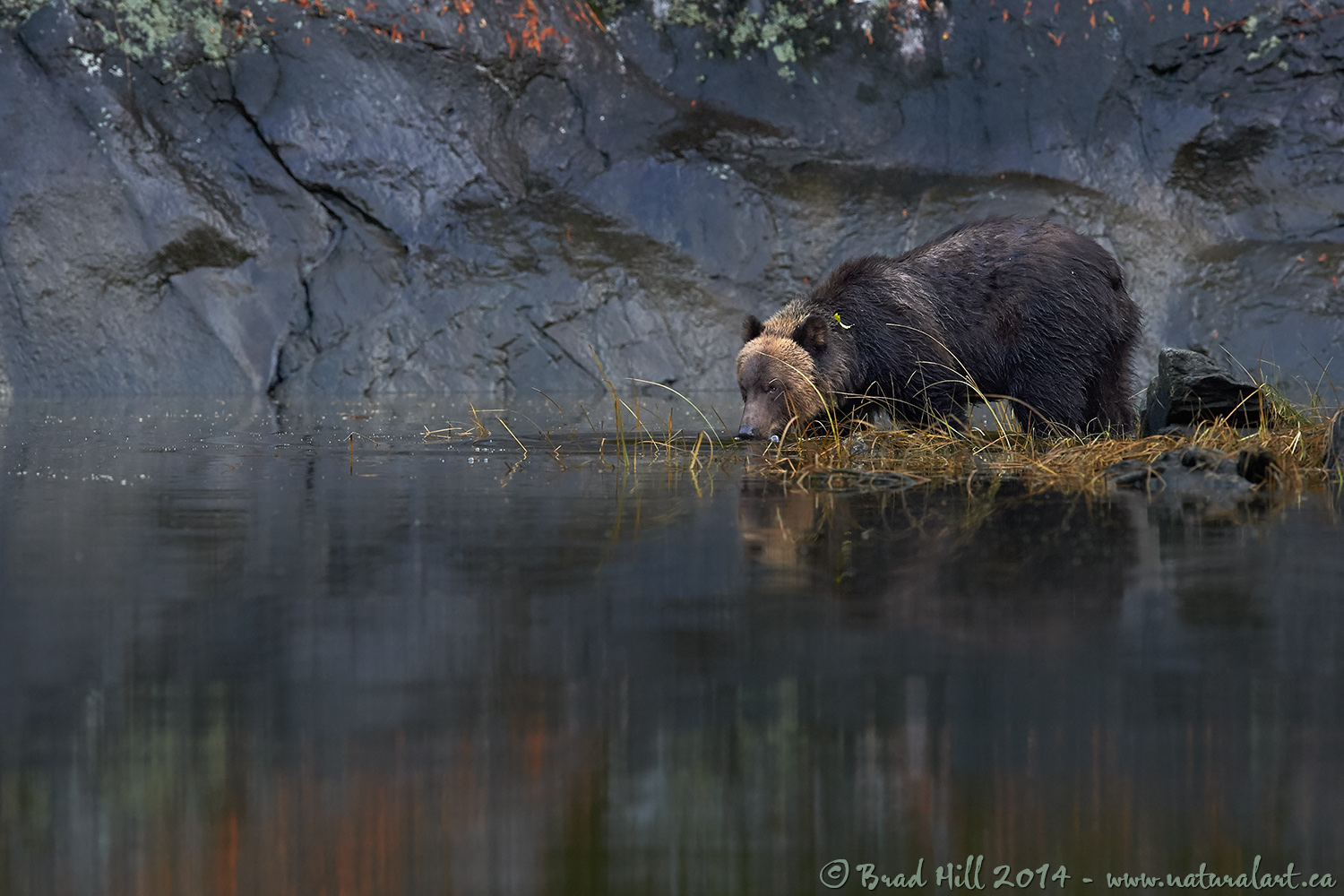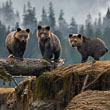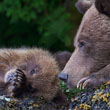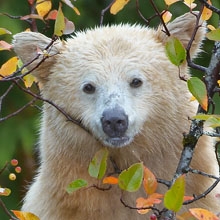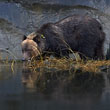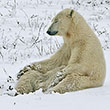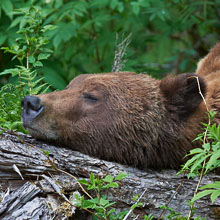Availability: Undetermined - Enquiries?
In the Field
Pausing at Land's End. Great Bear Rainforest (northern BC coast), BC, Canada. October 6, 2014.
There are times when wildlife photography can be a frustrating hobby (or profession) - so commonly things almost set up perfectly, but at the last minute something happens to destroy the scene or scenario you thought was about to come together right in front of you and you're left with...nothing! But every once in a while everything goes just right...and it feels just SO good - and it makes it all so worthwhile! For me, this shot was one of those times! As I saw the male grizzly slowly approaching the grassy point with that beautiful moss and lichen covered cliff as a backdrop and the beautifully dark and dead calm water in front of the bear (producing a strikingly coloured reflection) I was more than a little excited. Then the bear calmly approached land's end, paused, and bent down to take a drink. And, to top it off, I actually had the right lens on the right camera AND that combination was in my hands. Sweet! Someone was smiling on us at that moment!
This image brings up at least another couple of points worth discussing - one on the aesthetic side, and one on the geeky camera gear side. On the aesthetic side...I know some viewing this shot will feel that the tall grasses overlapping the bear detract from the shot. Personally I disagree. Nature isn't always perfectly clean, or organized or "ordered" the way we as photographers would like it to be. While I like shooting simple and "clean" images whenever I can, I think there are some photographers (or photo critics) out there that have taken the definition of what a visual "distraction" is just WAY too far. I have sufficient skills in Photoshop to have easily removed all of the overlapping grasses on this bear - including the ones that overlap the facial region and no one would have ever known (but me). But I have to say that I LIKE the grasses (especially those framing the eye), and wouldn't have felt good about misrepresenting the scene by removing them. I can't tell others what to do with their images or what to think, but spending a little time reconsidering what a visual distraction really is probably wouldn't be a waste of that time...
Onto the geeky stuff! I acquired the "new" Nikon 400mm f2.8E VR super-telephoto shortly before leaving on the trip where I captured this image. I had done a fair amount of testing of the lens before the trip so I was generally aware of how it performed and how darned good the lens was. But I hadn't fully developed an appreciation for was just how well the lens paired up with Nikon's latest teleconverters (both the 1.4x TC-14EIII and the 2x TC-20EIII). During the trip I became increasingly impressed with the quality of the images I could produce when I used the new 400 with either TC. This image was shot with the 400mm plus 1.4x TC - so at a focal length of 550mm. If you examine the 2400 pixel version (link below) it is hard to imagine how the image could be much sharper. Historically I've never been comfortable with using TC's, and I never thought I'd ever say this about them, but I'm now finding that I NEVER worry about the consequences of putting the 1.4x TC on the 400mm f2.8E VR...
This higher resolution version (2400 pixels) should give you a pretty good idea of the quality of shots I was getting with the Nikkor 400mm f2.8E VR when it was paired up with the 1.4x TC-14EIII teleconverter:
• Pausing at Land's End: Download 2400 pixel image (JPEG: 1.3 MB)
NOTES:
1. This image - in all resolutions - is protected by copyright. I'm fine with personal uses of it (including use as desktop backgrounds or screensavers on your own computer), but unauthorized commercial use of the image is prohibited by law. Thanks in advance for respecting my copyright!
2. Like all wildlife images on this website, the subject is fully wild and completely unconstrained. Besides the potential impact of my presence, nothing has been done to intentionally alter or affect the ongoing behavior of the subject and, of course, there has been no use of any form of bait or other form of wildlife attractants (including vocalizations).
3. This image was captured during one of my two autumn "Into the Great Bear Rainforest" photo tours in October of 2014. Each year I offer trips into two different parts of the Great Bear Rainforest as well as one to photograph aquatic mammals and oceanscapes near the northern tip of Vancouver Island. And, in selected years, I also offer photo tours to locations to capture other highly sought-after subjects, such as various boreal owl species and wildlife of Canada's Arctic. Details about these trips can be found on the Photo Tours page of this website.
Behind the Camera
Pausing at Land's End. Great Bear Rainforest (northern BC coast), BC, Canada. October 6, 2014.
Digital Capture; Compressed RAW (NEF) 14-bit format; ISO 3200.
Nikon D4s paired paired with Nikkor AF-S 400mm f2.8E VR plus 1.4x TC-14EIII teleconverter - hand-held from from Zodiac. VR on and in Sport mode.
1/640s @ f6.3; -1.0 stop compensation from "recommended" matrix-metered exposure setting.
At the Computer
Pausing at Land's End. Great Bear Rainforest (northern BC coast), BC, Canada. October 6, 2014.
RAW Conversion to 16-bit TIFF, including first-pass/capture sharpening using Phase One's Capture One Pro 8. Four raw variants (different versions of a single raw capture) processed, differing by a total of 0.5 stops in exposure.
Further digital corrections on resulting 16-bit TIFF files using Adobe's Photoshop CC 2014 and Light Crafts Lightzone. Photoshop adjustments included compositing (blending) of the four output files from the raw converter, selective colour desaturation, and selective sharpening for web output. Final tweaking of dark-on-dark tones on the bear's coat performed using LightZone's "tonemapper" tool.
Conservation
Pausing at Land's End. Great Bear Rainforest (northern BC coast), BC, Canada. October 6, 2014.
Ten percent of the revenue generated by this image will be donated to Raincoast*.
Species Status in Canada**: Special Concern (May 2002).
While Grizzly Bears (Ursus arctos) are not technically listed as "Endangered" in Canada, they have been extirpated from most of their historical range. Grizzly Bears are far more sensitive to intrusion/disturbance in their habitat than are Black Bears and are being increasingly forced into marginal habitat by human encroachment. The Great Bear Rainforest along the central and northern coast of British Columbia is one of the last strongholds of the Grizzly Bear in Canada, and even this population is coming under increasing pressure.
On December 18, 2017 the government of British Columbia banned grizzly hunting across the entire province. This major conservation victory came after decades of tireless work by many dedicated conservationists and ecologists and, most importantly, it reflects the opinion of the vast majority of British Columbians. And, it means that AT LEAST while the current government remains in power grizzlies are finally "safe" in British Columbia.
Now that we've at least temporarily won the battle to save grizzlies in BC, it's time to re-focus our efforts toward protecting ALL of BC's carnivores, including Gray Wolves, Black Bears, Cougars, Wolverines, and more! Simply put, there are no ecological, economic, or ethical arguments supporting the trophy hunting of carnivores.
In a great first step towards ending the hunting of carnivores throughout BC the Raincoast Conservation Foundation has developed a program designed to protect ALL carnivores within the Great Bear Rainforest. Details about this program can be found on this page on Raincoast's website. Check it out and, better yet, make a donation to help Raincoast purchase the remaining commercial hunting tenures in the Great Bear!
*The Raincoast Conservation Society (and Foundation) is an effective and efficient organization that has been fighting for protection of this unique habitat. If you are looking for a meaningful way to contribute to the conservation of this amazing ecosystem, Raincoast will provide maximal "bang" for your conservation dollars.
**as determined by COSEWIC: The Committee on the Status of Endangered Wildlife in Canada












